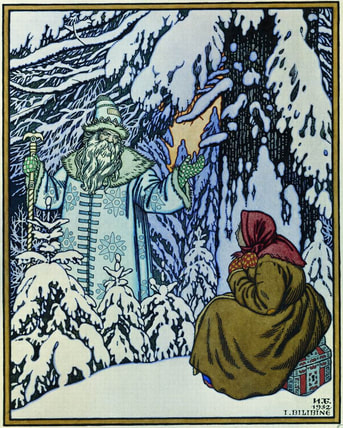|
Where did we get the idea of faeries in Summer and Winter Courts - or courts themed around all four seasons? Why does this appear so much in current fantasy novels? And what do they have to do with the Seelie and Unseelie Courts?
There are many legends of weather or seasonal spirits. Winter in particular has plenty of personifications. But these beings weren't necessarily fairies, and fairies weren't divided by seasons. If you go back to Shakespeare, Titania and Oberon were rulers over all the seasons. When did it get split up? This may have been a product of the Victorian era. Toned down for children, fairies became toothless things made primarily for education and edification. They were closely associated with nature and thus the seasons. There was some blurring of lines; this wasn't actually meant to promote genuine fairy belief, and often the "fairies" were poetic representations of insects, birds or plants. This was, after all, a way to educate kids on nature. In Victorian children's literature, fairies were responsible for painting the flowers, decorating the autumn leaves, or bringing snowflakes - and unlike Shakespeare, there were separate kingdoms. Fairies of spring, summer, autumn and winter worked in exclusive groups. In some books, they had their own monarchs, or there might be rivalries between groups. The Grand Christmas Pantomime Entitled Gosling the Great (1860) featured a fairy queen of spring named Azurina. "The Fairies of the Earth, and Their Hiding Places," by Lizzie Beach (1870) explained all of nature in fairy terms; Jack Frost was the king of the autumn and winter fairies. In the Libretto of the Fairy Operetta of the Naiad Queen (1872), the queens of each season are mentioned alongside queens of the fairies, sprites and flowers. Margaret T. Canby, in Birdie and his Fairie Friends (1873), included a story called "The Frost Fairies" in which Jack Frost is king over the fairies of winter. The trope of the seasonal fairy continued strong into the 20th century and continues to be popular. Julie Kagawa's Iron Fey series (beginning 2010) for one, features courts of Summer and Winter, while Disney's Tinker Bell animated movies (beginning 2008) put major emphasis on the fairies causing the seasons. But there's another factor that I believe is important here: The Oak King and the Holly King As mentioned, there are many myths to explain seasonal changes. Persephone is a classic seasonal myth. In Orcadian legend there is a constant struggle between the benevolent Sea Mither (Mother) and the evil storm spirit Teran who fight every spring and autumn. In Germany, Mother Holle was an legendary figure who created snow by shaking out her pillows. There were also holiday traditions where a person dressed as Summer defeated another dressed as Winter. In other cases, effigies were torn apart or thrown into the stream to celebrate the end of Winter. Robert Graves, in The White Goddess (1948), took influence from these rituals when he defined the Oak and Holly Kings. These were two gods who battled every year over a maiden representing Spring or fertility. The Oak King ruled during summer, but the Holly King defeated him and took over every winter. The yearly cycle goes on forever. Graves held that this was an actual myth that survived in multiple legends, and he had plenty of examples (Sir Gawaine and the Green Knight, for instance). In any story, if there are two men who fight (and particularly if there is a lady involved who can be connected to the Spring season), then there's your Oak and Holly King. It's very convenient. In fact, the Oak and Holly Kings are Graves' original creation, extrapolating from many different myths and the work of James Frazer. However, his work had a huge influence on modern paganism. For instance, Edain McCoy's popular 1994 book A Witch's Guide to Faery Folk is packed full of seasonal fairies as well as Gravesian mythology. Conclusion: Modern Times So in the twentieth century, you have a strong literary tradition of pretty little fairies being responsible for every change in season. And in addition to old myths of seasonal changes, you also have a newly popular neopagan theme of an unending power struggle between kings of Summer and Winter. However, what really tipped the scales was Jim Butcher's bestselling fantasy series: The Dresden Files. The 2002 novel Summer Knight introduced the fairy rulers. Butcher had the idea of conflating the seasons with the idea of the Seelie and Unseelie Courts - a concept from late Scottish folklore, which I examined recently on this blog. Thus, his fairies are split into two factions: the Seelie (or Summer) fae, ruled by Titania, and the Unseelie (or Winter) fae, ruled by Mab. Since the publication of this book, Butcher's system has grown huge in fairy fantasy - Titania and Mab as opposing seasonal queens, the seasons divided into Seelie and Unseelie, etc. Many authors seem to have lifted it wholesale straight from Butcher. And if Summer and Winter are courts, it seems reasonable enough that Spring and Autumn might also be courts, or that there might be other themed groups. Sarah J. Maas' series Court of Thorns and Roses has seven themed fairy courts (all four seasons, plus dawn, day and night). It is true that the Seelie Court is an old idea, as are good and evil fae, and fairies or other beings who influence the seasons. But originally, Seelie and Unseelie had nothing to do with the seasons. Thanks to popular literature, Jim Butcher's worldbuilding has grown popular enough to sometimes be confused for an old tradition. Other Blog Posts Text copyright © Writing in Margins, All Rights Reserved
2 Comments
|
About
Researching folktales and fairies, with a focus on common tale types. Archives
July 2024
Categories
All
|
Writing in Margins

 RSS Feed
RSS Feed
